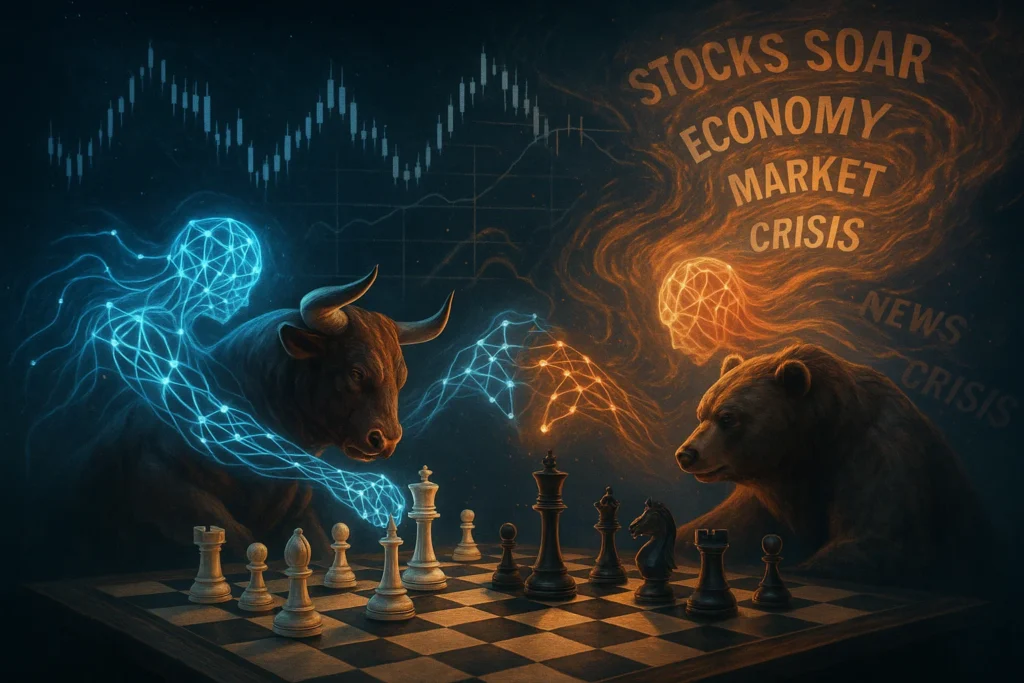When the Numbers No Longer Add Up
Why are markets so volatile when economic indicators seem steady? Why do strong earnings often lead to falling stock prices? This growing disconnect isn’t just a quirk of the modern market—it’s a sign of a deeper shift.
We’re now investing in a time when fundamentals matter, but they don’t always move the market. Instead, liquidity, sentiment, and speed often dominate — factors that are faster, less predictable, and less tied to value than traditional metrics like earnings or P/E ratios.
A recent feature in The Economic Times offers a compelling explanation. It traces how revolutions—from agriculture to algorithms—have historically redrawn the boundaries of power. And with each revolution, what society considers “valuable” has shifted. Land once defined wealth. Then machines. Then capital. Now, it’s intelligence—especially artificial intelligence. And that’s transforming the markets.
This isn’t just a shift in tools—it’s a shift in how belief is priced. As the article argues, we are no longer the sole authors of economic change. Algorithms now learn, react, and influence faster than human decision-makers. And in this new environment, market cycles vs fundamentals isn’t just a tactical question—it’s a survival strategy.
This article breaks down how that shift happened, why traditional investing models are falling short, and what kind of new thinking investors need to thrive in a post-fundamental, fast-turnover market
How Fundamentals Used to Drive Markets
There was a time when investing made sense.
You found a business with solid earnings, a clean balance sheet, and competent management. Maybe the P/E was low, maybe cash flows were strong. You bought the stock, held it, and—if you were right—it went up. Simple.
That was the era when fundamentals drove price, not the other way around.
Back then, markets had a rhythm. A bad quarter didn’t kill a stock. A good CEO could turn things around. Investors weren’t chasing charts—they were reading annual reports, doing DCFs, calculating margin of safety. Time moved slower. Belief built gradually.
And most importantly, patience paid off.
If you were early to a good story, you had time to sit tight. Stocks followed earnings. Price discovery was a process, not a race. Sure, there were corrections and crashes, but they were tied to something real—crude prices, interest rates, geopolitical shock.
Today? It’s a different universe.
Strong earnings? Down 6%. Beat estimates? No one cares. Post a funny meme? Stock rallies 40%.
We now live in a world where price often leads the story. Stocks run ahead of news, react to whispers, and fall apart on tweets. That’s the real tension at the heart of market cycles vs fundamentals. It’s not that fundamentals don’t matter—it’s that they’re often late to the party.
And the market doesn’t wait anymore.
We’ll dive into why this shift happened next—and how belief, bots, and bandwidth are now moving trillions, sometimes before a single earnings line is even read.
The Shift: Why Fundamentals Are No Longer Enough
So what changed?
It wasn’t just one thing—it was a convergence. A convergence of machines, money, and momentum.
The Economic Times article captured this perfectly: just as the agricultural and industrial revolutions redefined how power flowed—land, machines, capital—the intelligence revolution is redrawing financial power structures again. But this time, it’s quieter. There’s no guillotine or oil spill. It runs on silicon chips, cloud servers, and algorithms that teach themselves.
This is the new investing battlefield.
From Earnings to Algorithms
You’re no longer trading against another human reading a balance sheet. You’re trading against algorithms that are digesting headlines, pricing sentiment, tracking flows—and reacting in milliseconds.
AI don’t care about your DCF model. They care about positioning, option flows, and whether the VIX just moved a tick. AI front-run news, feed off volatility, and often create it. And when they move, they move fast.
This is why fundamentals lag. A stock might rally 20% in anticipation of results—then drop the moment earnings are announced, even if the numbers beat estimates. Because the market already priced in the belief, and when reality shows up, it’s no longer enough.
As The Economic Times put it: “We no longer price value—we price belief. And belief, increasingly, is built on noise.”
Liquidity > Logic
Add to that another layer: liquidity.
Years of loose central bank policy flooded the system with cheap money. That capital had to go somewhere. Valuations stretched. Loss-making startups raised billions. Meme stocks exploded. Passive funds distorted price discovery. And fundamentals became… optional.
When liquidity is high, markets behave like a confidence game. When it’s low, they behave like a casino fire drill.
Cycles get shorter. Everything gets faster. You don’t have time to “wait and see.” You have to “guess and react.” And if you’re playing the old game—fundamentals only—you’re playing without armor.
Narrative Is the New Metric
AI and algorithms don’t just read financials. Ai read trends. They optimize for emotion. AI scan Twitter, news headlines, Reddit threads. And when enough volume follows a narrative—whether it’s about EVs, rate cuts, or one stock going “parabolic”—the machines jump in. They don’t wait for confirmation. They create the price movement, and the herd follows.
This is why we now live in a market of rolling narratives and micro-cycles, where sectors go hot and cold in weeks, and conviction feels dangerous.
And it’s exactly where the friction between market cycles vs fundamentals plays out: where you’re right about the business, but wrong on timing. Or worse, the market moves against your thesis before your thesis even has a chance.
Investing Has Turned Into Timing
The biggest takeaway? The rules didn’t vanish—they just warped.
Fundamentals still matter—but they’re no longer the ignition switch. They’re the ballast. The weight. The gravity beneath a price.
But the spark? That comes from sentiment, liquidity, belief, positioning, and speed.
You can’t afford to ignore those anymore. Because in today’s market, investing isn’t just about being right—it’s about being early.
The New Market Playbook: How to Survive Cycles Without Abandoning Conviction
Let’s be clear: fundamentals still matter.
But in a market dominated by velocity, sentiment, and machine logic, how you use fundamentals matters more than ever. This isn’t about throwing out the old rules—it’s about learning when they apply and when they don’t.
If you’re investing today using only the playbook from 2005, you’re going to get whiplash. The pace is different. The signals are noisier. And conviction, without context, can be dangerous.
So what’s the new approach?
1. Think in Regimes, Not Quarters
You can’t just build a stock thesis and wait for it to play out. You have to understand the macro backdrop you’re in.
Are rates rising or falling? Is liquidity expanding or tightening?
What’s the Fed’s tone—hawkish or dovish? How strong is the dollar, and what’s it doing to capital flows?
These macro forces determine what kind of market we’re in—risk-on, risk-off, value rotation, growth dominance, defensive flight.
Before you ask, “Is this stock a buy?” ask, “Is this regime favorable to this kind of stock?”
That’s the context fundamental investors used to ignore—but in the age of market cycles vs fundamentals, it’s your starting point.
2. Follow Flows and Sentiment—Not Just Spreadsheets
Sentiment indicators like India VIX, FII/DII flows, and even sector-level open interest matter more than ever.
They tell you what the market feels—and markets move on feeling before they move on facts. Use tools like Google Trends, Put/Call Ratios, social chatter, and trend indicators. They’re not noise—they’re temperature checks.
If the mood is risk-off, your perfectly priced small cap with a 25% CAGR can still get crushed. Understand how narratives shape flows—and how flows shape prices.
3. Use Fundamentals as Anchors, Not Triggers
Here’s the truth: in this market, fundamentals are confirmation tools, not catalysts.
They tell you whether to stay in a trade—not necessarily when to enter it. A company’s strong balance sheet is your downside protection. Its margin growth is your anchor. But don’t expect these alone to move the needle unless the broader market wants them to.
That’s where cycles beat fundamentals—the market has to believe in your story before the numbers matter.
4. Embrace Tactical Agility—With Long-Term Discipline
You don’t have to become a trader. But you can’t be rigid, either.
Hold strong businesses, but don’t ignore signals that the market mood is shifting. Trim when sectors are frothy. Add when everyone is scared and liquidity is returning.
Have frameworks, not forecasts. Because in this environment, being half-right and agile beats being fully right and paralyzed.
5. Protect Against Narrative Risk
Finally, remember: narratives are now part of your portfolio risk.
Whether it’s AI, ESG, war, elections, or one viral headline, markets move on what people believe is coming—not what’s actually happening. That’s why portfolio construction needs buffers: cash, hedges, uncorrelated assets.
You can’t predict every storm, but you can stop sailing blind.
A New Discipline for a New Market
What we’re navigating now isn’t just noise—it’s a new layer of complexity. The investor of today must do what the old investor didn’t: price context, cycles, and crowd psychology, all without losing sight of what makes a business worth owning.
And that’s where the tension between market cycles vs fundamentals becomes a competitive edge—not a conflict.
Conclusion — What Happens When Belief Moves Faster Than Truth
In today’s markets, truth still matters—but belief gets priced first.
You might spend weeks building a rock-solid investment case, only to watch your thesis unravel in a single session because a global headline flipped sentiment. That doesn’t mean fundamentals are broken. It means they’re no longer the driver—they’re the ballast.
The Economic Times article that inspired this discussion made one thing clear: every major revolution—agricultural, industrial, political, now intelligence-driven—reshaped how power was distributed and value was created. In the world of investing, we are living through a similar revolution.
Algorithms, AI, narrative cycles, liquidity flows—these are the new levers of market movement. They’ve condensed the distance between anticipation and action. In this world, being right isn’t enough. Being early matters more.
That’s the crux of today’s dilemma: market cycles vs fundamentals is not a debate—it’s the dynamic. Investors can’t rely on a single system anymore. You need to blend conviction with context, valuation with velocity, and patience with adaptability.
What Does That Mean For You?
- Use fundamentals to build conviction, but let macro and sentiment shape your entries.
- Stay aware of narrative risk—markets move on story, not just spreadsheets.
- Watch flows and volatility indicators like India VIX—they’ll tell you what’s really driving price.
- Accept that we’re in a new regime—one where adaptability trumps analysis.
Because in the end, the most successful investors in this era won’t be those who only know how to value a company—they’ll be the ones who know when that valuation will matter.
That’s how you survive. That’s how you win.
FAQs:
What are market cycles?
Market cycles are phases of expansion and contraction in financial markets, driven by macroeconomic forces, liquidity, and investor sentiment.
How do fundamentals differ from market cycles?
Fundamentals reflect a company’s intrinsic value; market cycles reflect broader forces like sentiment, liquidity, and macro trends that can overshadow fundamentals in the short term.
Can fundamentals still guide investment decisions?
Yes, but in today’s fast-moving markets, they work best as long-term anchors rather than short-term entry signals.
Why do stocks fall even after good earnings?
Because expectations, positioning, or macro sentiment may already be priced in or turn unexpectedly negative.
What did The Economic Times article highlight?
It highlighted how every revolution—from agriculture to AI—reshapes power and belief, just as today’s markets price belief faster than truth.
What is narrative risk in investing?
It’s the risk of a stock moving on sentiment or trending stories rather than fundamentals, often triggered by social media, news, or macro events.
What should investors do in sentiment-driven markets?
Blend fundamentals with macro context, monitor flows, and manage risk by understanding market regimes.
Are cycles getting shorter?
Yes, thanks to real-time data, algorithmic trading, and constant global connectivity, cycles now unfold in weeks or months—not years.
How can I adapt my investment strategy?
Stay agile. Focus on quality but align with prevailing sentiment and macro environment. Time your entries with context.
Related Articles
China’s Fertilizer Export Halt to India: Stocks Set to Gain from the Supply Shock
Rare Earth Magnet Manufacturing Stocks: Catch These Before India’s ₹1,000 Cr Push Lifts Off
Ready-to-Drink (RTD) Cocktails: The Fastest-Growing Segment in the Liquor Market






